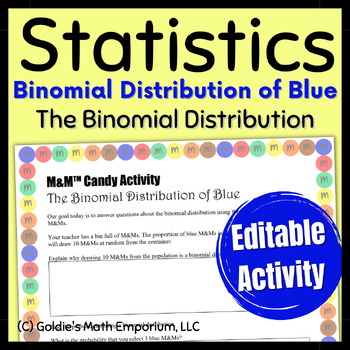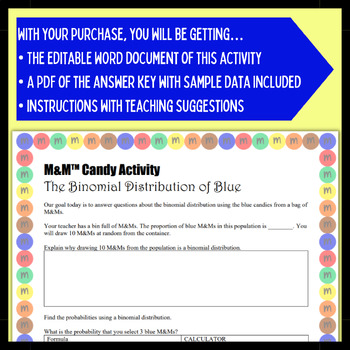Statistics Activity The Binomial Distribution
- Zip
Also included in
- Statistics Chocolate Candy Activity Bundle This bundle contains 10 activities that involve using M&M™ candies to understand, practice, and reinforce concepts throughout your statistics course. These activities can be used with your AP Statistics or regular level statistics class. Here are the foPrice $22.50Original Price $27.00Save $4.50
Description
Fun with Statistics
The Binomial Distribution using M&M™ candy
In this activity, students will practice setting up a binomial distribution and finding their probabilities. They will compare theoretical and empirical probabilities by sampling blue M&M candies from a population.
This activity can be used with your AP Statistics or regular level statistics class. These are the following skills covered:
Math Common Core Standards, High School: Probability and Statistics
- Define a random variable for a quantity of interest by assigning a numerical value to each event in a sample space; graph the corresponding probability distribution using the same graphical displays as for data distributions. (MD.A.1)
- Calculate the expected value of a random variable; interpret it as the mean of the probability distribution. (MD.A.2)
- Develop a probability distribution for a random variable defined for a sample space in which theoretical probabilities can be calculated; find the expected value. (MD.A.3)
- Develop a probability distribution for a random variable defined for a sample space in which probabilities are assigned empirically; find the expected value. (MD.A.4)
AP Statistics Course Exam Description
- UNC-3.A Estimate probabilities of binomial random variables using data from a simulation.
- UNC-3.B Calculate probabilities for a binomial distribution.
- UNC-3.C Calculate parameters for a binomial distribution.
- UNC-3.D Interpret probabilities and parameters for a binomial distribution.
This is a ZIP folder with the following:
- A Word document of the activity (both color and pure black and white)
- A PDF document of the activity (both color and pure black and white)
- A PDF answer key with sample data
- A PDF instruction page
***************************************************************************************
This product is included in the following:
- AP® Statistics Unit 4 – Probability, Random Variables, and Probability Distributions Unit Plans
- AP® Statistics Unit 4 – Projects and Activities
- Goldie's FULL CURRICULUM for AP® Statistics
- Statistics – Chocolate Candy Bundle
- Statistics: Random Variables
If you have the above products, you DO NOT need to purchase this separately.
*************************************************************************************** If you need extra explanations or additional guidance, I would love to help!! Contact me at goldiesmathemporium[at]gmail.com for any questions or samples.
AP® is a registered trademark of the College Board® which does not endorse this product.
I want to provide the best possible resources to help other teachers out! You will be notified of any future updates and additions to this product and it will be free of charge. Your support is important and I thank you for allowing me to continue doing what I love to do.
© Goldie’s Math Emporium, LLC
This work is bound by copyright laws and editing (beyond your own classroom use), selling, redistributing, or posting all or part of these documents on the Internet is strictly prohibited. Violations are subject to the Digital Millennium Copyright Act.




